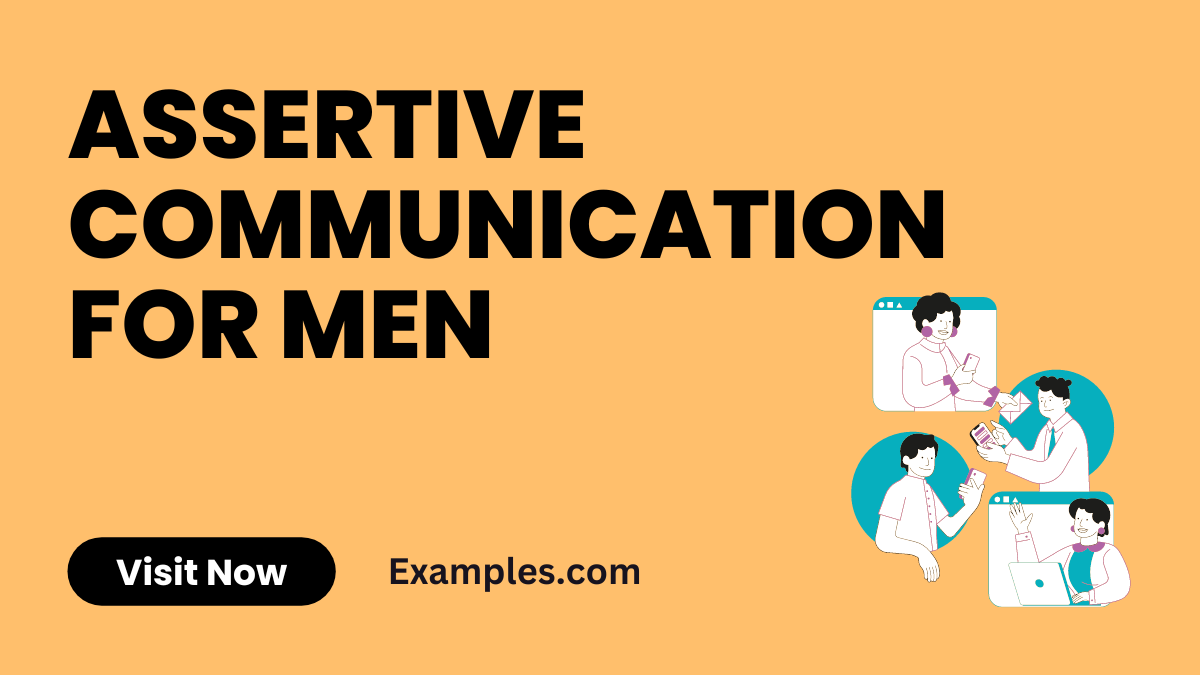19+ Assertive Communication for Men Examples
Assertive communication is a key skill for men in all walks of life, especially in areas of oral communication. This complete guide delves into practical examples of assertive communication tailored for men. It provides an insightful look into how men can express their needs and opinions clearly and confidently, without overriding others. From workplace interactions to personal relationships, these examples will illustrate the finesse of assertive communication, equipping men with the tools to navigate complex conversations with ease and confidence.
What is the Best Example of Assertive Communication for Men?

The best example of assertive communication for men often involves a scenario where a man needs to express his needs or opinions clearly and respectfully, without being aggressive or passive. For instance, in a professional setting, a man may use assertive communication to negotiate a salary increase. He could say, “Based on my recent achievements and the market value for my role, I would like to discuss the possibility of a salary adjustment.” This statement is direct and clear about his needs, yet it is respectful and open to dialogue, embodying the essence of assertive communication.
20 Assertive Communication for Men Examples
Assertive communication is a vital skill for men, enabling them to convey their thoughts and needs effectively while maintaining respect for others. This collection of 20 unique examples demonstrates how men can use assertive communication in various contexts. Each example is accompanied by a brief explanation and example sentences, showcasing the power of clear, respectful communication. These scenarios range from professional settings to personal interactions, offering practical insights for men to enhance their communication skills and interpersonal relationships.
- Requesting a Promotion:
“I believe my recent achievements qualify me for a promotion. Can we discuss this possibility?” Explaining your achievements and requesting a discussion about a promotion. - Declining Additional Work:
“While I’m committed to the team’s success, I can’t take on extra tasks without affecting my current projects.” Setting boundaries by respectfully declining additional work. - Negotiating Work Terms:
“I’d like to negotiate the terms of this project to better align with our mutual goals.” Initiating a negotiation in a professional and cooperative manner. - Addressing a Misunderstanding:
“There seems to be a misunderstanding. Let me clarify my point.” Clarifying a point to avoid miscommunication. - Handling Unfair Criticism:
“I’m open to feedback, but I’d prefer it to be constructive and fact-based.” Responding to criticism in a calm and constructive way. - Expressing a Contrary Opinion:
“I have a different perspective on this issue. Here’s my viewpoint…” Sharing a differing opinion in a respectful manner. - Asking for Help:
“I’m facing some challenges with this task and would appreciate your expertise.” Seeking assistance without hesitation.

- Turning Down an Invitation:
“Thank you for the invite, but I’m unable to attend due to prior commitments.” Politely declining an invitation. - Voicing Concerns in a Meeting:
“I have some concerns about this strategy that I’d like to discuss.” Bringing up concerns in a professional setting. - Advocating for a Team Member:
“I believe this team member has shown great potential and deserves recognition.” Supporting and advocating for a colleague. - Setting Personal Boundaries:
“I’m not comfortable discussing my private life at work. Let’s focus on the project.” Establishing personal boundaries in a professional environment. - Asking for Clarifications:
“Could you elaborate on that point? I want to ensure I fully understand.” Asking for more information to avoid misunderstandings. - Providing Constructive Feedback:
“Your work is impressive, but here’s a suggestion for further improvement.” Offering feedback that is both positive and helpful. - Rejecting Unsolicited Advice:
“I appreciate your input, but I’ve decided to approach this differently.” Politely declining advice while maintaining autonomy. - Stating Personal Needs:
“To perform at my best, I need to take a short break and recharge.” Expressing personal needs in a direct yet respectful manner. - Addressing Condescending Behavior:
“Please speak to me in a professional tone. Respect is essential in our communication.” Calling out and addressing condescending behavior.

- Negotiating Work-Life Balance:
“I need to adjust my working hours to better manage my personal commitments.” Negotiating for a more balanced work-life schedule. - Challenging Gender Stereotypes:
“Let’s evaluate people based on their abilities, not gender stereotypes.” Promoting equality and challenging stereotypes. - Asserting Personal Opinions:
“My view differs, and here’s why I think so…” Confidently stating a personal opinion. - Confronting Unfair Practices:
“This practice seems unfair. Can we discuss how to address this?” Addressing and discussing unfair practices constructively.
Assertive Communication Skills for Men
Developing assertive communication skills is crucial for men in enhancing their interpersonal effectiveness. This guide focuses on essential skills that foster clear, respectful, and confident communication. From body language mastery to the art of negotiation, these skills are integral in projecting assurance while being considerate of others’ perspectives. This SEO and NLP-friendly overview highlights key skills, offering men actionable strategies to refine their communication style, essential for success in both personal and professional spheres.
- Utilizing ‘I’ Statements:
“I feel concerned when my ideas are not considered during meetings.” Expressing personal feelings without placing blame. - Active Listening:
“I understand your point. Can you tell me more about your perspective?” Demonstrating attentive and empathetic listening. - Maintaining Eye Contact:
“While discussing, I maintain eye contact to show my engagement and confidence.” Using eye contact effectively to convey attentiveness. - Effective Body Language:
“My posture and gestures are open and confident during conversations.” Utilizing body language to reinforce verbal messages. - Clear and Concise Communication:
“Let’s focus on the main issue to find a solution quickly.” Conveying messages in a straightforward and focused manner. - Handling Criticism Constructively:
“I appreciate your feedback. How can I improve in this area?” Responding to criticism positively and seeking growth. - Expressing Disagreement Respectfully:
“While I see your point, I have a different view based on my analysis.” Respectfully expressing differing opinions. - Setting and Respecting Boundaries:
“I respect your time, so let’s schedule a meeting when it’s convenient for both.” Communicating boundaries while respecting others’ limits. - Negotiation Skills:
“Let’s find a middle ground that benefits us both.” Applying negotiation tactics for mutually beneficial solutions. - Confidence in Communication:
“I’m confident in my proposal and ready to discuss its merits.” Projecting confidence while discussing ideas or proposals.
What are the Characteristics of Assertive Communication for Men?
- Clarity in Expression: Assertive communication for men involves clear and direct expression of thoughts and feelings. This clarity helps in conveying messages without ambiguity, making interpersonal communication more effective.
- Respect for Self and Others: A key characteristic is balancing self-respect with respect for others. This balance is crucial in maintaining healthy professional communication and personal relationships.
- Confidence: Confidence in speech and demeanor is a hallmark of assertive communication. It’s about expressing oneself with assurance while respecting others’ viewpoints.
- Active Listening: Men who communicate assertively are also attentive listeners. They engage in active listening, showing empathy and understanding towards the speaker.
- Nonverbal Cues: Effective use of nonverbal communication, like maintaining eye contact and appropriate gestures, is integral. These cues enhance the overall impact of oral communication.
- Honesty: Being honest, yet tactful, is essential. It involves expressing genuine thoughts and feelings without causing offense or harm.
- Emotional Intelligence: Understanding and managing one’s emotions, as well as empathizing with others, are vital aspects of assertive communication for men.
- Solution-Oriented Approach: Assertive communicators focus on finding solutions and compromises, demonstrating their skills in conflict resolution communication.
What Does Men’s Assertive Communication Look Like?
- Expressing Needs Clearly: Men using assertive communication express their needs and wants directly but politely, demonstrating a key aspect of effective communication.
- Setting Boundaries: They are proficient in setting personal and professional boundaries, an important element of interpersonal communication.
- Assertive Body Language: Their body language reflects confidence and openness, important in nonverbal communication.
- Responding Calmly to Criticism: They handle criticism constructively, showcasing their skills in professional communication.
- Expressing Disagreement Diplomatically: Assertive communicators express disagreements respectfully, maintaining the decorum required in business communication.
- Seeking Clarifications: They are not hesitant to seek clarifications, ensuring a clear understanding in all forms of communication.
- Providing Constructive Feedback: Their feedback is specific, helpful, and delivered in a manner that encourages improvement, exemplifying good communication skills.
- Advocating for Themselves and Others: They advocate for their rights and the rights of others, an important aspect of leadership communication.
In conclusion, this comprehensive guide on “Assertive Communication for Men” provides valuable insights and practical examples for men to enhance their communication skills. By embracing the principles of assertiveness, men can effectively express themselves in various contexts, fostering respect, clarity, and confidence in both personal and professional interactions. The guide’s examples and tips serve as essential tools for men striving to communicate more effectively and assertively.
In summary, assertive communication for men is a pivotal skill in both personal and professional realms. It allows men to express their needs, opinions, and boundaries clearly and respectfully, fostering healthier relationships and more effective interactions. This approach is not about dominance but about confidence and respect – for oneself and for others. Men who master assertive communication can navigate complex social and professional landscapes with greater ease, demonstrating leadership qualities while maintaining empathy and understanding.
For those seeking to delve deeper into the principles of assertive communication, the American Psychological Association provides valuable resources on the topic. Their insights on communication styles and their psychological impacts can be explored here. Additionally, Harvard University’s online courses offer practical strategies and teachings in assertive communication, which can be accessed . These resources can serve as a further guide for men looking to refine their assertive communication skills.



